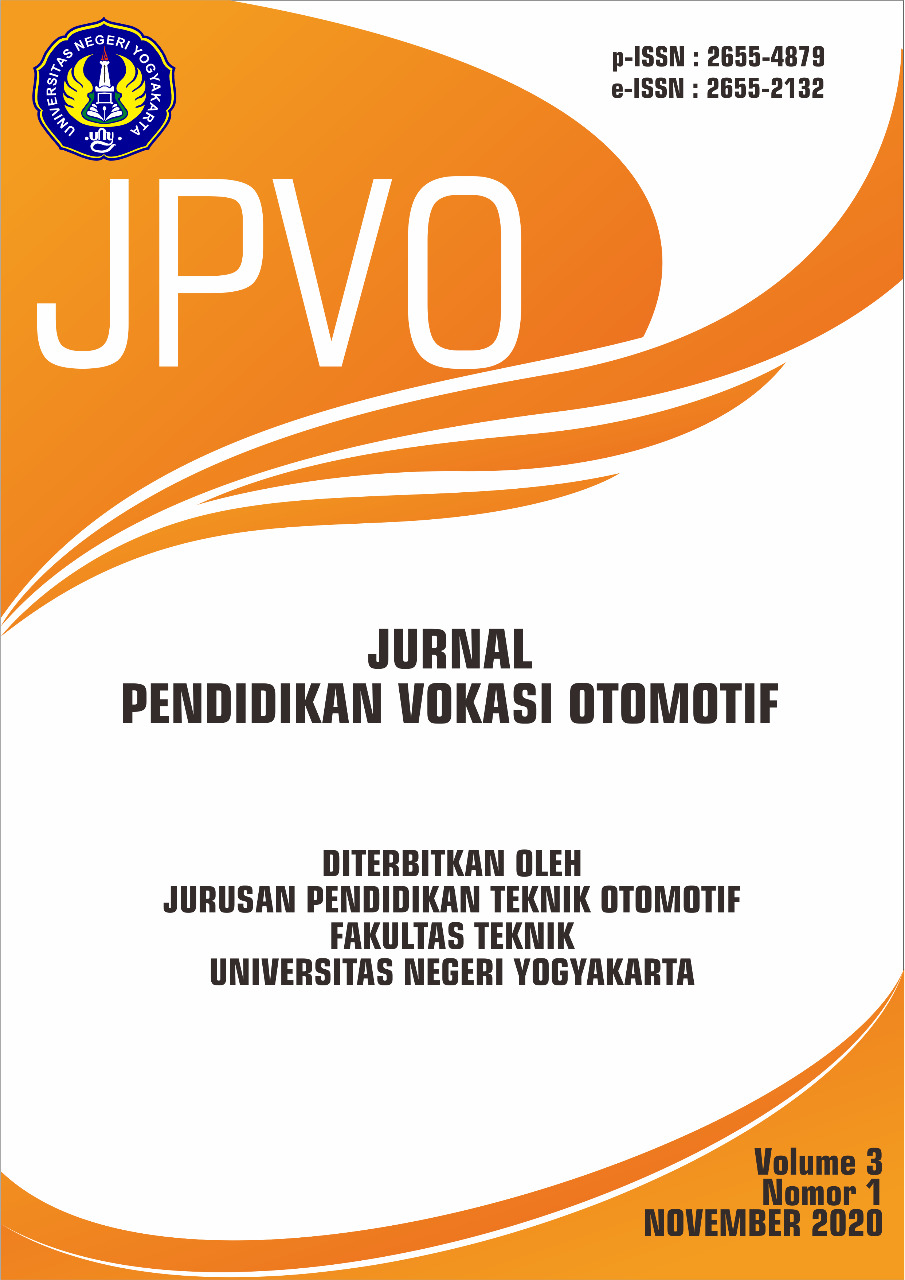DEVELOPMENT AND APPLICATION OF STEER-BY-WIRE (SBW) WITH LINEAR SENSORS TO A SMALL ELECTRIC VEHICLE
DOI:
https://doi.org/10.21831/jpvo.v7i1.79137Keywords:
steer-by-wire, linear sensor, small electric vehicle, straight and cornering test motions.Abstract
References
Ismail, Hasan, Chien-Hsun Chiang, and Wei-Hua Chieng. (2022). Onboard Sensor and Actuator Calibration of a Tripod Electric Vehicle Using Circular, Linear, and Cornering Motion Tests. SAE International Journal of Commercial Vehicles 16, no. 02-16-01-0006 (2022): 87-109.
S. A. Mortazavizadeh, A. Ghaderi, M. Ebrahimi and M. Hajian. (2020). Recent Developments in the Vehicle Steer-by-Wire System. IEEE Transactions on Transportation Electrification, vol. 6, no. 3, pp. 1226-1235. doi: 10.1109/TTE.2020.3004694.
P. Zhang, J. Tian, J. Hu and D. Wu (2024). Design of Variable Steering Ratio for Steer-by-Wire System Considering the Driver's Handling Skill. IEEE Access, vol. 12, pp. 110599-110609. doi: 10.1109/ACCESS.2024.3439697.
J. Huang, B. Xiao, H. Li and G. Xiang. (2018). Research on Dynamic Variable Transmission Ratio and Handling Stability for Steer by Wire Vehicle Based on Neural Network. 37th Chinese Control Conference (CCC), Wuhan, China, pp. 3279-3284. doi: 10.23919/ChiCC.2018.8482548.
Alekseeva, Natalia, Ivan Tanev, and Katsunori Shimohara. (2018). Evolving the Controller of Automated Steering of a Car in Slippery Road Conditions. Algorithms 11.7 (2018): 108.
M. B. Nor Shah, A. R. Husain, H. Aysan, S. Punnekkat, R. Dobrin and F. A. Bender. (2016). Error Handling Algorithm and Probabilistic Analysis Under Fault for CAN-Based Steer-by-Wire System. IEEE Transactions on Industrial Informatics, vol. 12, no. 3, pp. 1017-1034, June 2016, doi: 10.1109/TII.2016.2543232
D. Y. Song, Q. Li, F. L. Zou, and B. Yuan. (2008). Fault-Tolerant Control Architecture for Steering-by-Wire system. Proc. IEEE Symp. Intelligent Information Technology Application (IITA 07), IEEE Press, Dec. 2008, pp. 677-681.
W. Wang, X. Chen, and J. Wang. (2019). Motor-generator applications in electrified vehicle chassis-a survey. IEEE Transactions on Transportation Electrification, vol. 5, DOI 10.1109/TTE.2019.2934340, no. 3, pp. 584–60.
Robert Bosch GmbH. (2014). Bosch automotive electrics and automotive electronics: Systems and components. Networking and Hybrid Drive. Springer Vieweg.
S. A. Arogeti, D. Wang, C. B. Low, and M. Yu. (2012). Fault detection isolation and estimation in a vehicle steering system. IEEE Transactions on Industrial Electronics, vol. 59, no. 12, pp. 4810–4820.
L. Eckstein, L. Hesse, and M. Klein. (2014). Steer-by-wire, potential, and challenges. Encyclopedia of Automotive Engineering, pp. 1–14.
A. Gaedke, M. Heger, M. Sprinzl, S. Gruner, and A. Vahning (2017). Electric power steering systems. Steering Handbook, pp. 403–467. Springer, 2017.
Gessat, J. (2007). Electrically Powered Hydraulic Steering Systems for Light Commercial Vehicles. SAE Technical Paper 2007-01-4197. https://doi.org/10.4271/2007-01-4197.
B. Lequesne. (2015). Automotive electrification: The nonhybrid story. IEEE Transactions on Transportation Electrification, vol. 1 no. 1, pp. 40–53., DOI 10.1109/TTE.2015.2426573.
T.-H. Hu and C.-J. Yeh. (2009). Hardware implementation of the current control using the internal model method in the electric power steering application. 2009 IEEE Vehicle Power and Propulsion Conference, pp. 66–70. doi: 10.1109/VPPC.2009.52898.
L. Eckstein. (2016). Future trends for automotive steering systems. JTEKT engineering journal: JEJ/English edition, vol. 1013, pp. 2–7.
Wilwert C, Navet N, Song YQ, Simonot-Lion F. (2005) Design of automotive X-by-Wire systems. The Industrial Communication Technology Handbook.
Yu Lei-yan, Lin Yi, Shi Guo-Biao. (2007). Research on steering ratio of steer-by-wire system. Transactions of the Chinese Society for Agricultural Machinery, 38(8):190-192.
Downloads
Published
How to Cite
Issue
Section
Citation Check
License
Jurnal Pendidikan Vokasi Otomotif allows readers to read, download, copy, distribute, print, search, or link to the full texts of its articles and allow readers to use them for any other lawful purpose. The journal allows the author(s) to hold the copyright without restrictions. Finally, the journal allows the author(s) to retain publishing rights without restrictions

Jurnal Pendidikan Vokasi Otomotif is licensed under a Creative Commons Attribution-ShareAlike 4.0 International License.
Based on a work at https://journal.uny.ac.id/index.php/jpvo.









